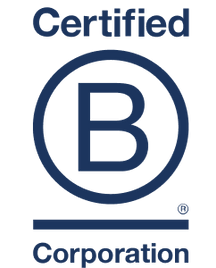The moment I heard the Producer Roaster Forum (PRF) was heading to Honduras, I knew I had to be there not just for the gathering of minds, but for the chance to finally experience a country that lives and breathes coffee. I'm Phil Head of Coffee at P&R, I’ve been fortunate to have tasted coffees from all over the world. But there’s something uniquely magnetic about Central America’s coffee origins. This trip wasn’t just another stop on the map, it was a dive into culture, connection and some of the most memorable cups I’ve ever had. This journey made me appreciate every part of the process of making coffee we all love.
The trip took me to San Pedro Sula, then south via Lake Yojoa all the way near the southern border of El Salvador, a coffee region near Marcala called San Jose, La Paz. This is the area we spent the bulk of our time on the Sourcing Trip Experience (STE), which was an extension of the PRF. It was on this trip that we got to immerse ourselves in Honduran coffee culture and taste so many delicious coffees. As an aside, if you’re curious about coffee from other countries, George from our Roasting Team wrote about his Vietnamese coffee adventures.
Over the course of three days, we visited several farms, sampled many delicious coffees, and met the faces behind the hard work on the coffee farms. This was concluded with a 2-day forum in San Pedro Sula, where I had the opportunity to meet more producers, sample more coffee, and attend a couple of lectures by leaders in the coffee industry.
“The trip really gives a newfound appreciation not just for the hard working people behind the coffee but the struggles the coffee plant itself has to go through to bring such coffee joy in every cup.”
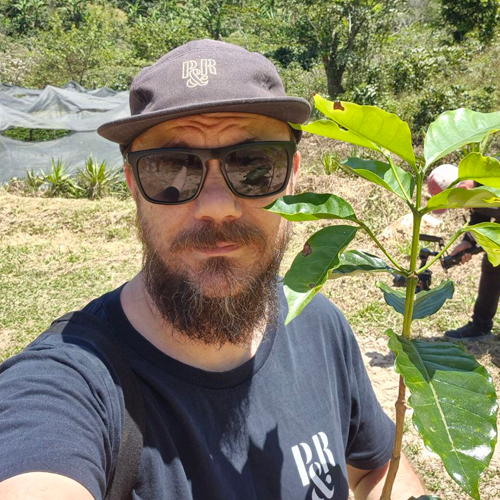
Day 1: The sourcing trip experience (STE)
STE was by far the highlight of the trip. With a crew of coffee professionals from all around the world, we embarked on a coffee adventure unlike any other. Gathering in a minibus from San Pedro Sula, Honduras, we started to get to know one another, getting settled for the long trek to Marcala. After a few hours of travel, when we reached Lake Yojoa we stopped off for some breakfast and bonding. We were introduced to the trip leader Hans from Five04 Coffee, he welcomed us all and went over the itinerary for the next few days, which was a packed schedule full of coffee farms and cuppings with a sprinkle of fun activities in between.
After filling ourselves with breakfast and local fruits, we set off again to Marcala. Once we arrived at the hotel, we quickly dropped off our things and headed straight to the first cupping. It was a good introduction to coffee grown in the region. We cupped over 3 rounds of coffees, ranging from high-quality Gesha varieties to traditional varieties suitable for blends. This was a great chance to dip our toes into the local coffees here and a chance to calibrate with the rest of the team on the trip.
Read more about Mick’s trip to Timor Leste or explore the cup of excellence of Nicaragua.
A glimpse into Finca San Francisco’s history
After around 3 hours of non-stop cupping, we gathered our things, jumped back in the bus and headed for our first farm visit to Finca San Francisco. This was a traditional farm, which has been running for over 100 years. We had the opportunity to experience the history of Honduran coffee firsthand by taking a tour of the antique wet mill.
Positioned on the side of the riverbank, this mostly wooden mill channels the water from the river to move the coffee cherry and run the equipment to pulp the coffee before fermentation. Regrettably, the mill is no longer in operation due to its proximity to the river and the more recent regulations that do not permit coffee processing so close to a shared water source. This is in an effort to minimise any contamination of local drinking water and the ecosystem downstream. Nonetheless, it was such a cool experience to see how coffee was once processed in the region and get a sense for how long coffee has been a vital part of the community.
A taste of local flavours & passion at Jumanti Cafe
We jumped back in the bus and then headed off to the local town centre. Here we visited a local specialty cafe: Jumanti Cafe, owned and run by the current Honduras National Aeropress runner-up, Rossy Arriaga. Here we got to taste some delicious coffees from her family farm, comparing them through a few different brewing methods, including the traditional Honduran using a metal pot and cotton filtration. This was a good end to such a great day, experiencing the passion of the local specialty coffee community and seeing firsthand the dedication to quality.

Day 2: Deep dive into sustainable farming
After a decent rest and a traditional breakfast of eggs, refried beans and tortillas, we set off for another big day. First on the agenda was a visit to Finca Bella Vista.
Organic practices & plant propagation at Finca Bella Vista
Tucked away in the lush highlands, Bella Vista is more than just a coffee farm, it’s a living, breathing ecosystem of sustainability, community and care. Every leaf, seed, and hand that touches this land is part of a deeper mission: to grow coffee in a way that honours the earth and empowers the people who tend it.
We were welcomed and shown around by Sara, the farm manager, who ensures that their practices are sustainable and promotes the hiring of women from nearby areas, offering stable livelihoods and building deeper roots between the farm and the families who live around it. She showed us the process of propagating and nurturing new plants to generate more coffee on the farm. With the restrictions on being an organic bio-farm, they can only use the plants they have onsite to generate seedlings.
It all starts with picking ripe cherries from the varieties selected to propagate from seed. These need to be healthy to ensure they have every chance of growing into a quality coffee producing plant. Once the cherries have been pulped, they are then submerged in water for around 24 hours to remove the protective mucilage on the coffee seeds.
When this process is finished, they are dried to around 25% moisture (much higher than the 11% needed for export and roasting) which allows the seed to get to a safe moisture level to stop fermentation but allow enough internal moisture to aid germination. Luckily, we got to experience this firsthand as we all took turns taking a handful of prepared coffee seeds and laid them out in the coarse sand.
Once the plants have grown into “soldiers” they then produce coffee leaves. This is now ready to be replanted and taken to the nursery. The little coffee plants are placed with soil and nutrients in a plant bag (this makes it more convenient for replanting later), where they can take another 9 to 12 months to grow strong enough to be ready for the real world.
Now the plants are ready; the land where they are going to grow needs to be selected and prepared. This is an experience we also got to be involved with. While we were in the nursery of Bella Vista, we all selected a plant each to perform the final step of planting, adding nutrition and watering. It was such a unique experience to be so hands-on in the process and really helped to give us a great understanding of how hard it is to just get the plant to the field.
With none of the steps along the process guaranteeing the plant will survive, it further adds to the appreciation of any coffee that eventually makes it. The plant we chose for P&R was a Pacamara variety, so we’ll see if it makes the full journey to our cup over the next few years. Watch this space!
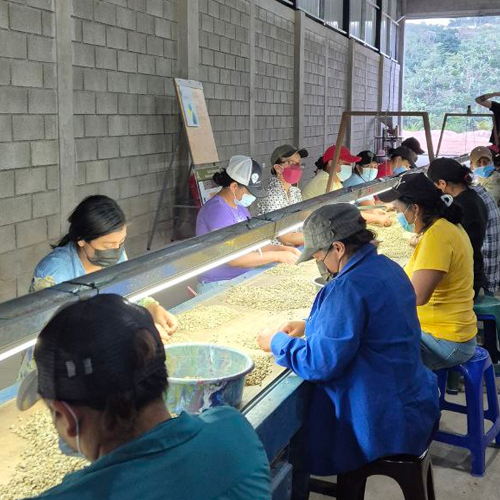
The dry mill & the art of hand sorting
After bidding a heartfelt goodbye to our little nursery plants, we made our way to the dry mill for the next chapter of the Bella Vista journey. The scale of the mill alone was impressive. Not only does it process coffee from the farm itself, but it also serves smallholder farmers in the surrounding region, making it a vital hub for the local coffee community. From density and size sorters to dehulling equipment, this gets the coffee prepared for the final step of quality sorting.
Unlike many dry mills that rely on colour laser sorters to remove defects, Bella Vista takes a different approach, one rooted in people. Here, hand-sorting is still the method of choice. It’s a deliberate decision that speaks volumes. By choosing people over machines, Bella Vista continues to create jobs for local women, many of whom rely on this work as their primary source of income.
Again, we were able to experience hand sorting firsthand. Sitting around the sorting table, we were given the task of seeing how much we could sort out in 5 minutes. This was no easy feat as we had to first identify which beans had the defect then pick them out and keep them separated. Trying to move quickly to do this seemed impossible, as it requires such good hand-eye coordination. You don’t want to be picking out any good coffee and leaving any defective coffees behind
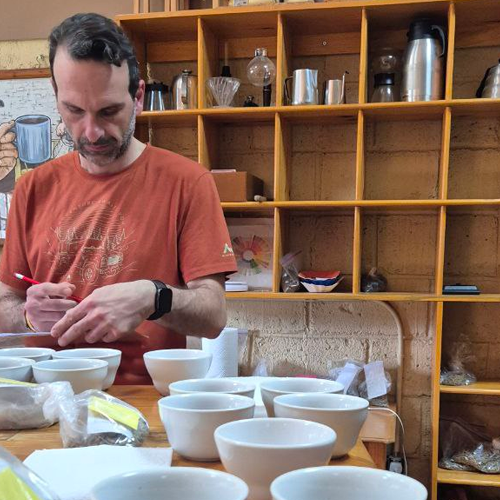
The eye-opening cupping of defects
Fresh from the dry mill, we hopped on the bus and headed straight for the cupping tables, expecting a full session, but not the surprise that awaited us.
The first table wasn’t just a tasting, it was a test. Unbeknownst to us, the farm’s quality team had spiked several cups with intentional defects to show what happens when sorting or processing isn’t done right. We encountered phenolic, mouldy and sour cups, each with its own story of where things can go wrong.
Phenol tasted medicinal, often a result of over-fermentation or contamination, which can occur from cherries drying on the tree. Mould was unmistakably musty, typically caused by poor or uneven drying. Sour beans gave a sharp, off-balance tang, usually from over-fermenting at various stages.
At home, we rarely taste these flaws thanks to rigorous sorting and grading. But this exercise gave us a real appreciation for the behind-the-scenes work that ensures only high-quality coffee ends up in our cups. Every clean, vibrant brew is the result of careful attention at every step, from harvest, fermentation, drying and sorting to get the perfect grind size and serve the best coffee.
It was a reminder that great coffee doesn’t happen by accident.
After the lesson in cupping defects, we got to experience some truly delicious coffees, coffee that scored well up around the 90 point mark (which is rare!). This was very much welcomed after cupping such oddly tasting coffees like the phenolic and mouldy coffee. After a few tables of specialty grade and non-defect coffees it was time to turn in and get some rest for what will be another big day and our last one before we make the long trek back to San Pedro Sula.
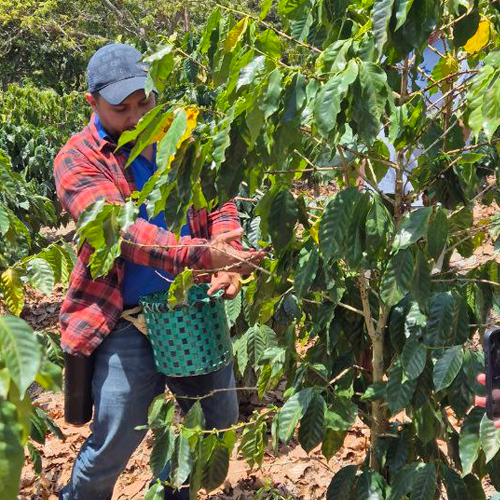
Day 3: Farm visit to Finca Villa Gloria & integrated management
On the final day in Marcala, we got to visit another farm in the area called Finca Villa Gloria (this is Rossy Arriaga’s farm). As we were visiting after harvest, there were no cherries being picked but rather post harvest tasks were underway. The main one we got to see here was trimming of the plants to get rid of any damaged or excess branches on the coffee tree.
The plant cropping serves a few different functions. The first is to remove any damaged or unusable branches that will end up taking away energy or utilising any of the valuable nutrients that the plant will need to grow healthy, quality coffee. The second is to open up the plant to more direct sunlight as overgrown plants can stop the light from reaching further down the tree. The last is to manage the size of the tree, if the tree is allowed to grow untouched, it can hinder access to the plantation and can grow so high that it is almost impossible for anyone to harvest cherries from the highest point without machinery or breaking the plant.
Consequently, the farm manager showed us what they do to prevent any diseases in the plants. The first one he explained to us was managing leaf rust. The best way to try and get on top of the spread here is through early detection. They take note of the plants and plantations affected by leaf rust and its severity to understand its spread and location, so they can best utilise their resources in managing the disease.
He also taught us about the coffee berry borer disease. This is a little insect that tunnels into the coffee cherries and lays eggs, feeding on the seed or green bean. This can be very detrimental as it lowers the quality of the coffee and reduces the yield of the plant. At Finca Villa Gloria, they set traps up every 20 meters to entice the bugs. They use old plastic bottles fashioned into traps fitted with ethanol filled bags. The ethanol recreates the pheromones that attract the female berry borers. These traps act as a protection for the trees in the area but also as an indicator for how prevalent they are, giving them time to act if needed.
After adventuring through the farm, we took a quick stop at the wet mill to see how they operate while visiting the old wet mill site. This is an ancient circular brick well in the ground that was used almost 100 years ago to pulp cherries before they are sent to be fermented. Cherries were placed in the well with donkeys pulling circular rocks around the well to push the seeds out of the cherries by crushing them. We've definitely come a long way.
Calibrated palates & delicious discoveries
Once we finished up at Finca Villa Gloria, it was time to go cup some more. Another 4 flights of coffees one after another, cupping some of the most delicious coffees you’ll find in the area. Now we had experienced a few flights of cupping over the last couple of days. It really felt like we were well calibrated and we were more comfortable sharing tasting notes and cupping scores. There were all sorts of flavours from chocolate and caramel through to wild berries, mango, pineapple and jasmine. A range of scores from 84 through to 90 showcasing the variable profiles and qualities that Honduras can produce.
Although it’s tough to cup through so many coffees late into the day/night, it is such an honor to cup them knowing more about the battle a coffee plant goes through in its life to produce the amazing tasting coffee that we all know and love.
A newfound appreciation
After a nice dinner at Bella Vista and then a good sleep, it was time to hop on the bus the next morning and head back to San Pedro Sula. It was a relaxing trip, tired from adventuring through the multiple coffee farms and learning so much. But it was the “getting hands-on experience” and “getting a little dirty” (I may have fallen into one of the ditches at one stage..) that really drove home the information.
Over the few days we were there, it was like we got to live parts of the life of the coffee plant alongside it. The trip really gives a newfound appreciation not just for the hard working people behind the coffee but the struggles the coffee plant itself has to go through to bring such coffee joy in every cup.
Appreciate great coffee? Check them out HERE.

